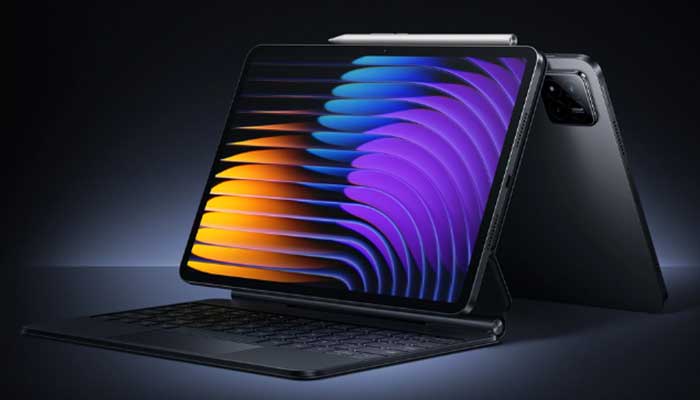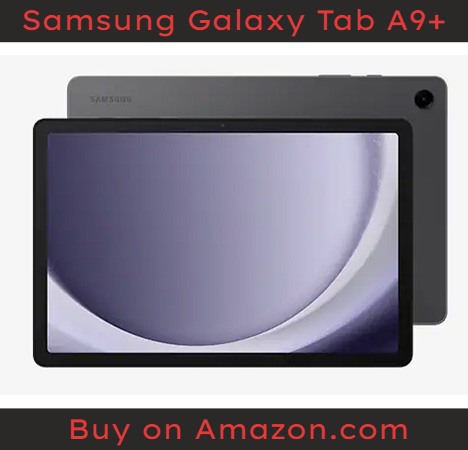
The newest tablet in Xiaomi’s portfolio, the Pad 7 Pro, is aimed toward those who enjoy multimedia and productivity. It competes with premium tablets from well-known manufacturers, due to its elegant design, strong internal components, and feature-rich display. Here is a detailed analysis of its capabilities and features, concluding with a list of the main advantages and disadvantages.
The combination of the glass front and the metal black and frame gives the Xiaomi Pad 7 Pro a high-end vibe. With dimensions of 251.2 x 173.4 x 6.2 mm and a weight of 500 grams, the tablet is small and light, making it perfect for prolonged use. With its sleek lines and contemporary design, its build quality equals that of more costly rivals.
While the magnetic stylus support increases its appeal for note-taking and creative work, the lack of SIM card compatibility is consistent with its orientation as a Wi-Fi-first tablet. The tablet comes in three different color options to accommodate a range of tastes – Black, Blue, and Green.
Xiaomi Pad 7 Pro’s display is one of its best qualities. With a resolution of 2136 x 3200 pixels, the 11.2-inch IPS LCD display has a sharp 344 PPI density. For multimedia entertainment, its support for HDR10 and Dolby Vision ensure rich colors and striking contrasts.
Additionally, the display boasts an amazing refresh rate of 144Hz, that makes animation and scrolling incredibly fluid. With a maximum brightness of 800 nits and 68 billion colors, it works well in a variety of lighting settings including outdoor ones. Although the always-on display is more convenient, users might want to purchase a screen protector because the protection feature is ordinary.
Built on a 4nm technology, the Qualcomm Snapdragon 8s Gen 3 CPU powers the Xiaomi Pad 7 Pro. A powerful Cortex-X4 core running at 3.0 GHz is part of the octa-core CPU design which provides outstanding responsiveness. The tablet manages demanding programs, gaming, and multitasking with ease because of its Adreno 735 GPU.
The tablet can accommodate both casual and heavy users with RAM options of 8GB and 12GB and storage capacities ranging from 128GB (UFS 3.1) to 512GB (UFS 4.0). Users looking for extra capacity may be put off by the lack of a microSD card slot, although the various models provide enough room for the majority of needs.
The HyperOS 2 from Xiaomi which is based on Android 15, offers a smooth and simple user interface. The OS offers a variety of customization choices and seamless navigation; because of its good hardware integration.
The Xiaomi Pad 7 Pro has a good camera setup. The dual rear camera has a 2MP depth sensor for portrait effects and a 50MP primary sensor with PDAF for crisp, detailed images. Versatility in various lighting circumstances is improved by the LED flash and HDR compatibility.
The tablet is appropriate for recreational filmmaking because it can shoot videos at 60 frames per second with up to 4K resolution. Clear video calls are ensured by the 32MP front camera which also records 1080p video at 30 frames per second and produces great selfies. Although the tablet’s camera system is amazing, it’s crucial to remember that it is not meant to take the role of a smartphone or specialized camera.
The Xiaomi Pad 7 Pro’s quad-speaker system with stereo output makes it an excellent audio device. Rich and engrossing, the sound is appropriate for music, movies, and video games. However, customers who depend on wired headphones might consider the lack of a 3.5mm headphone connection inconvenient. This deficiency is partially offset by support for Hi-Res and Hi-Res Wireless Audio.
Advanced communication technologies supported by the tablet include Bluetooth with LHDC 5, Wi-Fi 7, and a USB Type-C 3.2 port for quick data transfers. However, its usefulness for some users might be limited by the absence of FM radio, NFC, and positioning services (GPS).
A sturdy 8850mAh battery powers the Xiaomi Pad 7 Pro, providing sustained use. Xiaomi’s 67W wired fast charging with PD3.0 and QC3+ technology allows for up to 40% charge in just minutes. Because of this, it’s a great option for frequent users who want fast top-ups.
Support for magnetic styluses greatly increases the tablet’s allure for productivity users and creative. Whether taking notes, sketching, or annotating documents, the stylus’s capability is responsive and fluid. The stylus itself, however, it offered for sale separately; raising the total cost.
Pros
- Features a premium metal frame and a slim and light design.
- Outstanding display with 11.2-inch IPS LCD with a refresh rate of 144Hz, HDR10, and Dolby Vision.
- The Snapdragon 8s Gen 3 chipset offers a large amount of RAM and storage capacity.
- A good camera setup includes a 50MP primary camera and a 32MP selfie camera that supports 4K video.
- 67W quick charging and 8850mAh capacity.
- Stylus support promotes creativity and efficiency.
- Hi-Res audio by using a quad speaker arrangement.
Cons
- No SIM support, Wi-Fi only, limiting connectivity while on the road.
- No expandable storage.
- Lack of FM radio, GPS, or NFC.
Xiaomi Pad 7 Pro is a great example of how to combine advanced functionality and cost. It is a fantastic option for both productivity and leisure because of its striking display, strong performance, and adaptable design.
Although some networking features and SIM support are absent, these are negligible in comparison to its overall capabilities. The Xiaomi Pad 7 Pro offers outstanding value in a stylish and contemporary package, regardless of whether you’re a student, creative worker, or casual user.

Leave a Reply